home | internet service | web design | business directory | bulletin board | advertise | events calendar | contact | weather | cams

|
True Grist 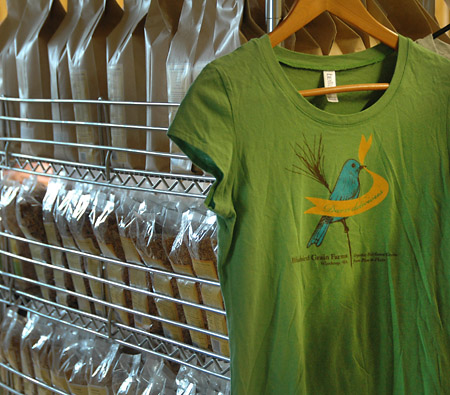 Bluebird Grain Farms locally grown products have become a familiar item on Methow Valley store shelves. Bluebird Grain Farms locally grown products have become a familiar item on Methow Valley store shelves.Brooke and Sam Lucy invited the public on a tour of their local farmstead recently, and talked to a well-bundled and appreciative audience about their farming, their grains, and their marketing. “The whole thing was just kind of start-and-see-what-happens,” said Sam. What happened is a family business, Bluebird Grain Farms, that produces grain that is both certified organic by the U.S. government and also ‘salmon safe’—a qualification from the Oregon-based Pacific Rivers Council that is more difficult to obtain, Brooke explained. The ‘salmon safe’ assessment looks at the whole watershed, and how water is used as the grain is produced. The isolated Methow Valley is a good grain-growing climate and organic grains are the only expanding sector of US agriculture, according to Sam. Bluebird's’ home base in the Rendezvous area includes their first granary - a four compartment wooden structure designed by Sam and local architect Doug Potter. Since then, they have added three metal granaries at the main farm and one in the Twin Lakes area. 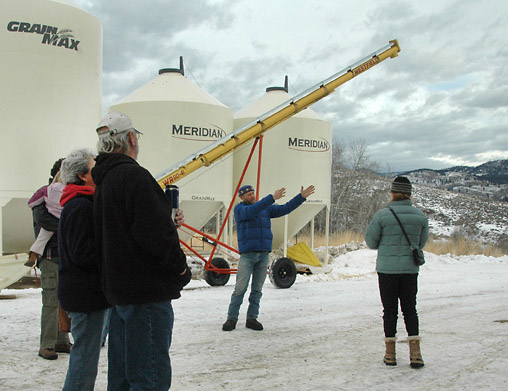 Sam Lucy explains how they have expanded from the original wood grain storage building to the metal granaries seen behind him. Sam Lucy explains how they have expanded from the original wood grain storage building to the metal granaries seen behind him.About 200 acres of leased fields in the Methow produce about 50 bushels per acre of wheat and 60 to 70 bushels per acre of emmer, an ancient strain of wheat also called farro. Two hundred acres is easily enough to meet the grain needs of Methow Valley residents, if that was ever necessary, Sam said. The Lucys hope to expand their farming to 250 acres over time. Each year about a third of the acreage in production is “green cropped” by planting a type of vetch that adds nitrogen to the soil and loosens any compacted soil before it is plowed back into the field for fertilizer. From around the end of August until the middle of October Bluebird Farms harvests wheat that is stored in the granaries for the year. But “it’s milled freshly on a weekly basis, according to whatever orders come in,” said Sam. “We do everything pretty much to order.” Local bakeries and Glover Street Market order weekly, and the farm also supplies other local grocery stores. Orders come in by phone and on the internet, some from Puget Sound restaurants. Only 10 to 15 percent of the annual crop gets sent outside Washington. Roughly 30-35% is sold locally. 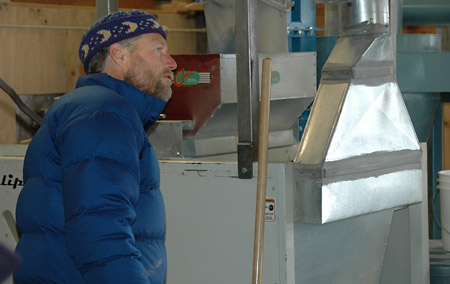 Sam shows how harvested grain is removed from hulls, if necessary, and cleaned using specialzed machinery. Sam shows how harvested grain is removed from hulls, if necessary, and cleaned using specialzed machinery.Bluebird Farms made a conscious decision not to get into transporting their grain orders. Instead they rely on freight companies, United Parcel Service, and the US Post Office to move their products outside the Methow. Much of their product is handled by a distributor. Emmer wheat, once cultivated in the ancient world, is Bluebird Farm’s star crop. It caught the attention of Seattle area restaurants and food establishments when Puget Consumer Cooperative started serving whole-grain cooked emmer in their delicatessens. “The Seattle market is amazing,” Sam said. Bluebird Grain Farms is miniscule compared to the sprawling wheat farms in places such as southeast Washington. “Our challenge has been finding (grain-processing) equipment small enough,” Sam explained. 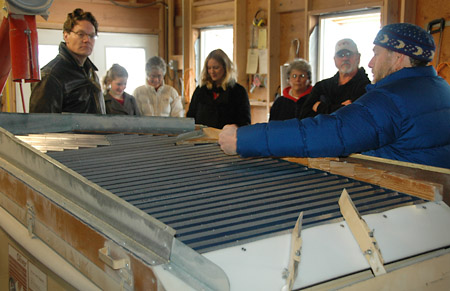 The hulled and cleaned grain is then separated by weight using gravity. The hulled and cleaned grain is then separated by weight using gravity.When the Methow harvest begins, cut grain rides an auger from the harvester into the wagons or trucks. Modern grains “have been bred over the years to come out of the hull easier,” Sam said, meaning their hulls mostly fall away in the field as they are harvested. Bluebird Farm’s signature crop, emmer, is actually two grains inside one hull that takes more work to remove. “Emmer takes extra processing.” Specialized machinery inside the Bluebird Farms building does that work and the hulls are blown out of the building into containers. The grain then passes to the gravity deck. “I bought that just for its name,” Sam Lucy joked. The gravity deck works on the same principal as gold panning - weight is used to separate materials. The grain runs over a slanted bed that shakes: the heavier grains move down while the lighter materials ‘float’ to the top. Any rocks fall out. The grain is cleaned and ‘sized’ with whole grains separated from the broken ‘splits’. Some splits are used as cracked-grain cereal, some become part of their best-selling pilaf mix, and some are ground into flour. 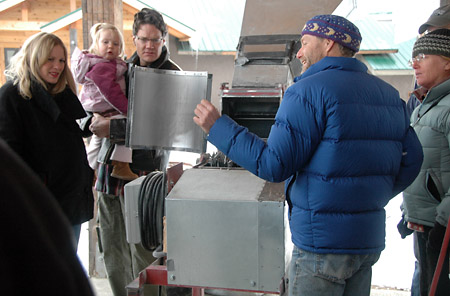 During milling of the grain screens determine the fineness of the flour. During milling of the grain screens determine the fineness of the flour.About two-thirds of the grade one emmer is sold as whole grain. The rest joins the splits to become cracked-grain cereal or be ground into flour. Walt Hagermeister runs most of the processing machines. "It's not as dusty as you might think, explained Sam, "but it does get noisy. We try to keep the flour outside. Flour dust is very explosive.” Three basic kinds of mills grind grain into flour, according to Sam: roller mills, hammer mills and stone mills. He said that stone mills are good, but also expensive, costly and slow. So Bluebird Farms has a hammer mill. It sits on a porch outside and is powered by one of the tractors when it’s running. The hammer mill does what it sounds like—hammers the grain into flour, to be used in such delicious things as the cookies and brownies served as holiday treats during the tour. 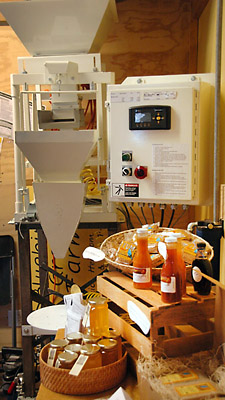 The last step in production is packaging, done with the help of this machine. The last step in production is packaging, done with the help of this machine.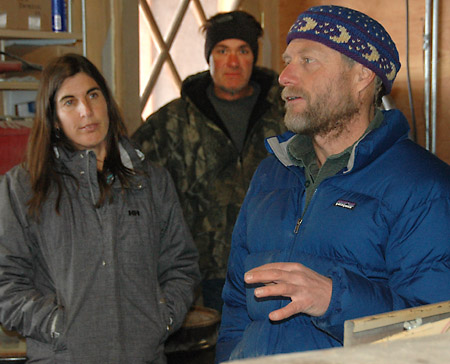 Brooke Lucy,Walt Hagermeister and Sam Lucy are the heart of Bluebird Grain Farms, along with equipment, knowledge, luck and a lot of hard work. Brooke Lucy,Walt Hagermeister and Sam Lucy are the heart of Bluebird Grain Farms, along with equipment, knowledge, luck and a lot of hard work.Another tour is scheduled for December 17, starting at 10:30 am. Next spring, when the bluebirds show up, Bluebird Grain Farms will start its ninth year of production by planting their own saved seed into Methow Valley fields. By fall that crop will be showing up on store shelves in the valley as a variety of products, including their new chef-designed pasta flour mix. Look for the bluebird. 12/8/2011 |